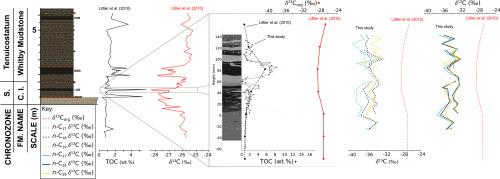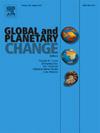Global carbon cycle disruption during the latest Pliensbachian (Lower Jurassic) evidenced by simultaneous isotopic depletion in marine and terrestrial carbon pools
IF 4
1区 地球科学
Q1 GEOGRAPHY, PHYSICAL
引用次数: 0
Abstract
The Pliensbachian-Toarcian (Pl-To) boundary was marked by an extinction event in marine organisms, and localised ocean anoxia – resulting in the deposition of black shales. Negative isotopic excursions in bulk organic carbon in many of these black shales, are widely believed to indicate that a global carbon cycle disruption accompanied this extinction event. The Pl-To preceded a period of more intense global carbon cycle disruption that occurred during the Toarcian Oceanic Anoxic Event (T-OAE) by around a million years. It is evident from targeted carbon isotopic analyses of marine and terrestrial organic matter that simultaneous disruptions to the marine and terrestrial carbon cycles occurred during the T-OAE. However, it remains a matter of debate whether the main source of carbon emissions was a climate-sensitive methane reservoir, or volcanic processes. No records of terrestrial carbon cycle disruption exist for the latest Pliensbachian, and so the causal mechanisms behind localised anoxia in this stage of the Lower Jurassic are poorly constrained. We present a record of concomitant isotopic depletion in short and long-chain n-alkanes derived from a thin black shale (the Lower Sulphur Band – LSB) deposited during the latest Pliensbachian (located in Yorkshire, UK). A key argument is that simultaneous isotopic depletions in these different compound classes implies the presence of a brief global hyperthermal event in the latest Pliensbachian, with a timescale too short to have been captured by previous analyses of the Yorkshire section. We discuss the relevance of our data to the stratigraphic record of the Lower Jurassic sediments of Yorkshire, highlighting, in particular, the need for better constraint on the ammonite biostratigraphy of the study section. We further argue that the brief climate disruption that occurred in the latest Pliensbachian made the shallow marine environment vulnerable to the development of more widespread marine anoxia, during the succeeding Toarcian stage.

海洋碳库和陆地碳库同时发生同位素损耗,证明最近的普利恩巴赫期(下侏罗世)全球碳循环中断
普利恩巴赫-托阿克(Pliensbachian-Toarcian,Pl-To)边界的标志是海洋生物的灭绝事件和局部海洋缺氧--导致了黑色页岩的沉积。人们普遍认为,许多黑色页岩中大量有机碳的负同位素偏移表明,伴随着这次生物灭绝事件,全球碳循环发生了紊乱。Pl-To比托尔干大洋缺氧事件(Toarcian Oceanic Anoxic Event,T-OAE)期间发生的更为剧烈的全球碳循环紊乱期早了约一百万年。对海洋和陆地有机物进行的有针对性的碳同位素分析表明,在 T-OAE 期间,海洋和陆地碳循环同时中断。然而,碳排放的主要来源是对气候敏感的甲烷库,还是火山过程,这仍然是一个争论不休的问题。最近的普利恩巴赫期没有陆地碳循环中断的记录,因此对下侏罗世这一阶段局部缺氧背后的成因机制还不甚了解。我们提供了一份短链和长链正构烷烃的同步同位素损耗记录,该记录来自最晚普利恩巴赫期沉积的黑色薄页岩(下硫带-LSB)(位于英国约克郡)。一个关键的论点是,这些不同化合物类别中同时出现的同位素损耗意味着在最近的普利恩巴赫期存在一个短暂的全球高热事件,而这个事件的时间尺度太短,约克郡剖面以前的分析无法捕捉到。我们讨论了我们的数据与约克郡下侏罗世沉积物地层记录的相关性,特别强调需要更好地制约研究区段的氨虫生物地层学。我们还认为,在最近的普利恩巴赫期发生的短暂气候破坏使得浅海环境在随后的托阿克期容易受到更广泛的海洋缺氧现象的影响。
本文章由计算机程序翻译,如有差异,请以英文原文为准。
求助全文
约1分钟内获得全文
求助全文
来源期刊

Global and Planetary Change
地学天文-地球科学综合
CiteScore
7.40
自引率
10.30%
发文量
226
审稿时长
63 days
期刊介绍:
The objective of the journal Global and Planetary Change is to provide a multi-disciplinary overview of the processes taking place in the Earth System and involved in planetary change over time. The journal focuses on records of the past and current state of the earth system, and future scenarios , and their link to global environmental change. Regional or process-oriented studies are welcome if they discuss global implications. Topics include, but are not limited to, changes in the dynamics and composition of the atmosphere, oceans and cryosphere, as well as climate change, sea level variation, observations/modelling of Earth processes from deep to (near-)surface and their coupling, global ecology, biogeography and the resilience/thresholds in ecosystems.
Key criteria for the consideration of manuscripts are (a) the relevance for the global scientific community and/or (b) the wider implications for global scale problems, preferably combined with (c) having a significance beyond a single discipline. A clear focus on key processes associated with planetary scale change is strongly encouraged.
Manuscripts can be submitted as either research contributions or as a review article. Every effort should be made towards the presentation of research outcomes in an understandable way for a broad readership.
 求助内容:
求助内容: 应助结果提醒方式:
应助结果提醒方式:


